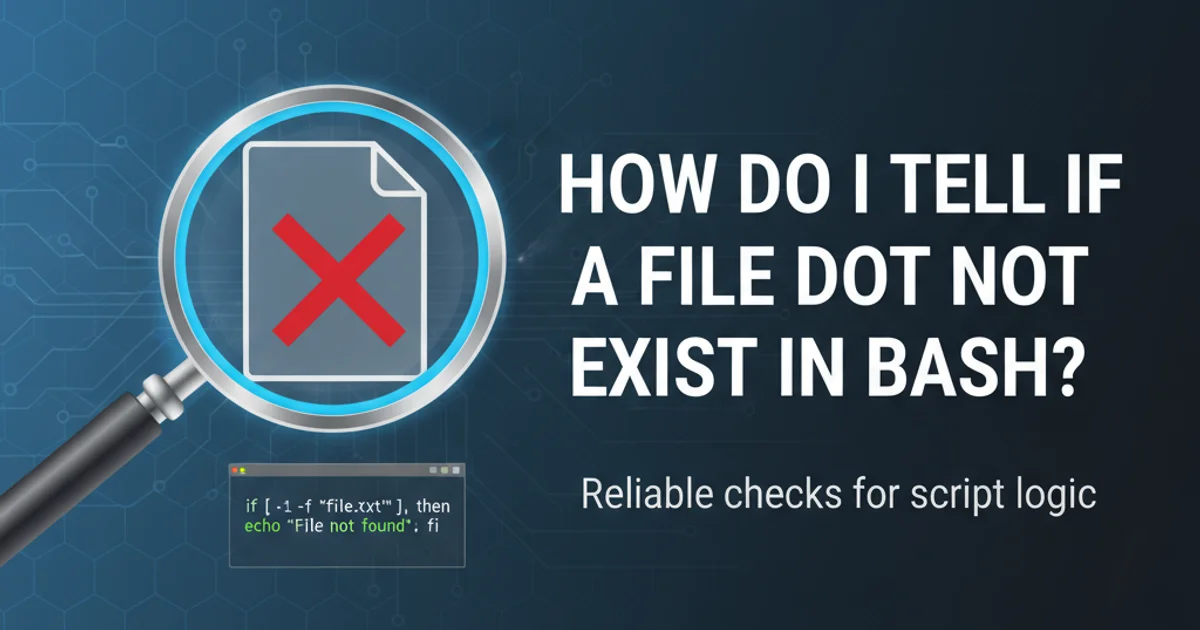How do I tell if a file does not exist in Bash?
Categories:
How to Check if a File Does Not Exist in Bash

Learn various robust methods to determine if a file or directory does not exist in Bash scripting, ensuring reliable script execution.
In Bash scripting, verifying the existence or non-existence of files and directories is a fundamental operation. This is crucial for preventing errors, ensuring data integrity, and controlling script flow. This article will guide you through several common and robust methods to check if a file or directory does not exist, along with best practices and considerations for different scenarios.
Understanding Bash File Test Operators
Bash provides a set of built-in test operators that allow you to query various attributes of files and directories. These operators are typically used within if statements or [[ ... ]] conditional expressions. The primary operator for checking non-existence is ! -f for regular files and ! -d for directories. The ! negates the result of the test.
flowchart TD
A[Start Script] --> B{File Path Provided?}
B -->|No| C[Exit: Missing Path]
B -->|Yes| D{Is it a Regular File? ( -f )}
D -->|Yes| E[File Exists]
D -->|No| F{Is it a Directory? ( -d )}
F -->|Yes| G[Directory Exists]
F -->|No| H[File/Directory Does NOT Exist]
E --> I[Continue Script (File Exists)]
G --> I
H --> J[Handle Non-Existence]
J --> K[End Script]Decision flow for checking file existence in Bash
Method 1: Using ! -f for Non-Existent Regular Files
The ! -f operator checks if a path does not refer to a regular file. This is the most common way to ensure that a file you intend to create or operate on doesn't already exist as a regular file. It's important to note that -f returns true for regular files, but not for directories or special files.
FILE="/tmp/my_new_file.txt"
if [ ! -f "$FILE" ]; then
echo "File '$FILE' does not exist as a regular file. Creating it..."
touch "$FILE"
else
echo "File '$FILE' already exists as a regular file."
fi
Checking for a non-existent regular file using ! -f
Method 2: Using ! -d for Non-Existent Directories
Similar to ! -f, the ! -d operator checks if a path does not refer to a directory. This is useful when you need to create a directory only if it doesn't already exist, preventing errors from mkdir.
DIR="/tmp/my_new_directory"
if [ ! -d "$DIR" ]; then
echo "Directory '$DIR' does not exist. Creating it..."
mkdir -p "$DIR"
else
echo "Directory '$DIR' already exists."
fi
Checking for a non-existent directory using ! -d
Method 3: Checking for Any Non-Existent File System Entry (! -e)
If you want to check if any file system entry (regular file, directory, symbolic link, device file, etc.) does not exist at a given path, you can use the ! -e operator. This is a more general check for non-existence.
PATH_TO_CHECK="/tmp/non_existent_item"
if [ ! -e "$PATH_TO_CHECK" ]; then
echo "Path '$PATH_TO_CHECK' does not exist."
else
echo "Path '$PATH_TO_CHECK' exists."
fi
Checking for any non-existent file system entry using ! -e
"$FILE") within [ or [[ to prevent issues with spaces or special characters in filenames. Using [[ ... ]] is generally preferred over [ ... ] for its enhanced features and fewer quoting pitfalls.Combining Checks and Best Practices
You can combine these checks using logical operators like && (AND) and || (OR) within [[ ... ]] for more complex conditions. For instance, you might want to check if a path doesn't exist or if it exists but isn't a regular file.
FILE="/tmp/another_file.txt"
# Check if it doesn't exist OR if it exists but is not a regular file
if [[ ! -e "$FILE" || ( -e "$FILE" && ! -f "$FILE" ) ]]; then
echo "'$FILE' does not exist or is not a regular file. Creating/overwriting..."
echo "Hello from Bash!" > "$FILE"
else
echo "'$FILE' exists and is a regular file."
fi
Combined check for non-existence or not being a regular file
Practical Steps for File Existence Checks
Here are some practical steps to integrate file existence checks into your Bash scripts.
1. Define the File/Directory Path
Start by defining the full path to the file or directory you want to check in a variable. This makes your script more readable and easier to modify.
2. Choose the Appropriate Test Operator
Decide whether you need to check for a regular file (-f), a directory (-d), or any file system entry (-e). Use the ! operator to negate the check for non-existence.
3. Implement with if and [[ ... ]]
Wrap your test operator in an if statement using [[ ... ]] for robust conditional logic. Always quote your variables to handle spaces and special characters correctly.
4. Handle Both Outcomes
Provide clear actions for both scenarios: when the file/directory does not exist (e.g., create it, log an error) and when it does (e.g., proceed with operations, skip creation).
5. Add Error Handling (Optional but Recommended)
For critical scripts, include error handling. If a required file doesn't exist, you might want to exit the script with an error code and a descriptive message.